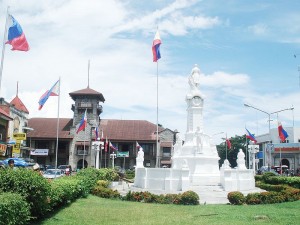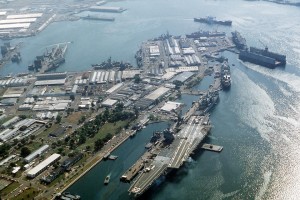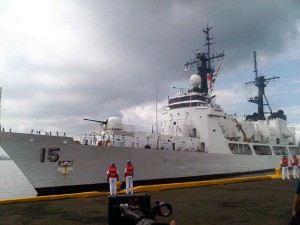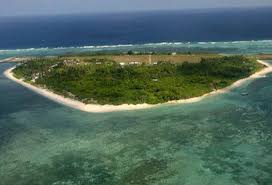
Despite regular coverage of ongoing events in Zamboanga City by both the Philippine and world press, there is still bafflingly little information available regarding the invasion and possible attempted takeover of the city on the southeastern tip of the island of Mindanao by fighters from a faction of the Moro National Liberation Front (MNLF). Recent reports from the Armed Forces of the Philippines on 16 September claimed that “70 percent of the coastal areas in Zamboanga City that were occupied by Muslim rebels” had been recaptured by Monday, with military “and special police forces” having “killed or arrested more than 100” rebels occupying “five coastal villages” after what has been described as a “foiled attempt” at occupying the city hall (or an attempt to raise the rebels’ flag) on 8 September. 82,000 of the approximately 1 million Zamboanga residents had been forced from their homes due to the fighting.
The Philippine Navy’s response
The Philippine military’s maritime forces have been very much involved in the response to the attacks in Zamboanga, with an afloat encounter between the rebels and AFP Navy Special Operations personnel at sea being described in most reports as the initial event of the standoff. The unit most likely involved in that incident was Naval Special Operations Unit Six (NAVSOU 6), the component of the Philippine Naval Special Operations Group (NAVSOG), based out of Naval Station Romulo Espaldon in Zamboanga City and under the operational control of Naval Forces Western Mindanao (NFWM), the naval component of the AFP’s Western Mindanao Command (WESTMINCOM), the command responsible for military operations in the Sulu Archipelago and the western half of Mindanao. According to the AFP, ships and troops already based in Zamboanga have been augmented by “4 units provided by the Naval Special Operations Group” and 300 Marines.
Who is responsible?
A faction of the MNLF has been blamed for these events in most reports. The MNLF was originally founded in the 1960s and represented a variety of Muslim ethnic groups resident in the southern Philippines. Since its early years the group has been led by Nur Misuari, a native of Jolo Island (although Misuari is a Sama, not a Tausug like most Jolo residents). The Moro Islamic Liberation Front (MILF) separated from the MNLF in the late 1970s, with much of the split between the two groups being reflecting ethnic differences (the MILF is typically strongest in Maranao and Maguindanao area on Minadanao, with Tausugs from Jolo forming the backbone of the MNLF). The Al Qaeda-linked terrorist (and criminal) group Aby Sayyaf is itself an early-nineties splinter from the MNLF by natives of Jolo and Basilan.
In 1996 the Philippine government and the MNLF negotiated a peace that established the Autonomous Region of Muslim Mindanao (ARMM), composed of Muslim-majority provinces in the Sulu Archipelago (Basilan, Jolo, and Tawi Tawi) and on mainland Mindanao. Nur Misuari became the first governor of the ARMM and MNLF cadres were to be incorporated into the Philippine military. However, by 2001 he had been pushed out of his leadership role within the MNLF and, seeing the writing on the wall, led a an armed revolt on Jolo against both the remaining MNLF leadership and the Philippine government and military. After fleeing to Malaysia Misuari was arrested and deported back to the Philippines, remaining in custody until 2008. The forces of what has since been called the “Misuari Breakaway Group” (MBG) or “Misuari Renegade Group” (MRG) has been led by Habier Malik, who has also been identified as the leader of the Zamboanga attacks in much of the reporting.
Conflict between the MILF and MNLF has been sparked again in the last year due to the announcement last October that Manila and the MILF had reached their own peace agreement, the Framework Agreement on the Bangsamoro, which essentially replaces the MNLF-dominated ARMM by a new entity that will presumably be controlled by the MILF. Since the Framework was announced in 2012, there has been a variety of attempts to embarrass the government of Philippine President Benigno Aquino III. The most high profile, and bizarre, event was the February “stand-off” between followers of the Sultan of Sulu and Malaysian authorities in Sabah, on Borneo. Misuari “extended his support” to this venture and in August, “declared the independence of Mindanao and the establishment of the Bangsamoro Republik, which included Mindanao, Palawan in southwestern Philippines and Sabah in Malaysia.” Although Misuari has been widely blamed for the last week’s events in Zamboanga, his involvement is still unclear, with the Zamboanga City mayor stating that Misuari had “disowned” Habier Malik and the attack, while his lawyer has said that Misuari “was directing the MNLF fighters’ movements.”
A Violent History
Violence in Jolo and Zamboanga City has often been entwined. The 2010 bombing at the Zamboanga City airport that killed two people has generally been described as an attempted assassination against the governor of Jolo. In October 2002 a US Army soldier was killed in a bombing in Zamboanga City, and in 2009 two additional US soldiers were killed in an IED attack on Jolo that was attributed to the MNLF and the “Bangsamoro National Liberation Army.” Zamboanga City and the surrounding areas have been the site of numerous high-profile kidnappings against foreigners. An invasion on the scale of these most recent attacks, however, does seem like a significant escalation. It is likely an act of desperation by Misuari’s faction of the MNLF, but it is still unclear what they expected to achieve by taking the fight off Jolo, unlike in 2001.
What does this mean for the USA?
I attempted to weigh the relative success or failure of US counter-terrorism in the Philippines in an article in Small Wars Journal last year, with the predictable conclusion that the results were mixed. Of note, NAVSOU 6 is one of the units that has received training from US Special Operations Forces. Despite linkages between the various Muslim terrorist, nationalist, or rebel groups in the southern Philippines, however, the US has focused its activities to supporting the Philippine military in its fight against groups like Abu Sayyaf, not groups like the MNLF and MILF. With peace with the MILF and Abu Sayyaf on the decline, however, it seems that fallout from politics is more likely to be a source of discord in the Philippines than Al Qaeda-linked extremist groups.
Lieutenant Commander Mark Munson is a Naval Intelligence officer currently serving on the OPNAV staff. He has previously served at Naval Special Warfare Group FOUR, the Office of Naval Intelligence, and onboard USS ESSEX (LHD 2). In 2010 he deployed as the Intelligence Officer for Task Force Archipelago, the Naval Special Warfare component of Joint Special Operations Task Force-Philippines. The views expressed are solely those of the author and do not reflect the official viewpoints or policies of the Department of Defense or the US Government.




